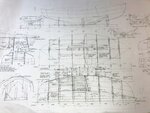

It started a year ago. Or maybe it started 60 years ago, when John Carlson, 75, built his first boat. Or maybe it was just 40 years ago when John and his wife Helen bought their 28-foot Herreshoff wooden sloop, Rozinante.
Many Key Peninsula residents will recognize John’s name as the accomplished house builder of Carlson Builders. (Real old-timers may remember it as Lakebay Woodworks.)
“I started out in Seattle doing small cabinet jobs and little repair things,” John said. “When we moved down here to Home in 1979, I was doing similar things and just stuck at it long enough until it actually worked.”
He built several houses on the KP. “I don’t really know how many houses I’ve built, dozens anyway over my career,” he said. “I wasn’t a large builder at all — just one at a time.”
John designed many of them. “I’d say it was an equal split between architect projects and people that came to me with ideas. But I thought then and still think that having a structural engineer is an inexpensive way of ensuring that what you’re building is going to stand.”
He retired from house building in 2014. Now he’s building something else.
“I grew up in the North End of Tacoma and I used to hang around the Point Defiance boathouse,” he said. “When I was 14 or 15 my brother and I decided we were going to build a boat. It was a little motorboat, an 11-foot B Class runabout. We had a 9-horse Johnson or something; it probably went about 20 miles an hour. It was great fun going around Vashon Island and down in the Narrows.”
A few years later John graduated from the University of Washington with his wife, Helen. They bought a house in North Seattle, soon followed by Rozinante.
“We were pretty taken with her,” he said. “We’d had canoes and kayaks, and we were hell-bent on the idea of getting some kind of a boat.”
They sailed Rozinante up and down the Sound with their two children for 31 years. After they sold her in 2006, John set out to fill the void. He built a 12-foot sharpie designed by Olympia boatbuilder Sam Devlin. Then he commissioned Devlin to build John’s design of a small, 1930s-era overnighter powerboat. A year ago in October, he started building his own design.
Elena is an 18 1/2-foot stitch-and-glue sloop with a 7-foot beam that will weigh 1,800 pounds empty and carry 200 square feet of sail, which is large for her size.
Stitch-and-glue construction is a modern building technique made possible by epoxy, fiberglass, and marine plywood. Thin ply panels are stitched together with copper wire around molds or to permanent frames to shape the hull, then glued together with strips of fiberglass. The wires are removed, and the hull is often glassed again and coated with epoxy to stiffen and waterproof it to create a relatively light, rot-resistant and durable vessel.
The technique also provides an easy entry into boatbuilding for the home builder.
“I came up with this myself, but it’s sort of a combination of our experiences with different boats over the years,” John said. “I wanted to have some of the same attributes that Rozinante had, namely just enough weight to carry it easily and not be constantly changing sails; to be comfortable on the boat.”
Elena started as a drawing, then a pattern, and then three scale models over two years.
“Most of that time was spent thinking about it,” John said.
“It looks like a pretty classic design, but maybe it’s more accurate to say it’s a design with classic elements,” he said.
“I think it’s possible to build a reasonably successful sailboat if it has reasonably fair lines, all things being equal, and you put the sail in the right place,” he said. “It’s bound to do something no matter how good or bad it is.”
John said it will take at least another year to finish the build. If so, that would be four years he spent on the project.
Why?
“I’m getting old,” he said.
“There’s a joy to building things, and in particular boats, that nobody else has ever built before. The trick is to not move too quickly when you’re traveling in uncertain territory. If you wait long enough and think about things, a reasonable solution will reveal itself, at least as far as building is concerned. I’ve found that to be the case along the way with intended hopes, imagined successes, or utility that are sometimes not exactly what we had in mind. But Elena, as a learning experience, it has worked extremely well.”
UNDERWRITTEN BY THE FUND FOR NONPROFIT NEWS (NEWSMATCH) AT THE MIAMI FOUNDATION, THE ANGEL GUILD, ADVERTISERS, DONORS AND PEOPLE WHO SUPPORT INDEPENDENT, NONPROFIT LOCAL NEWS